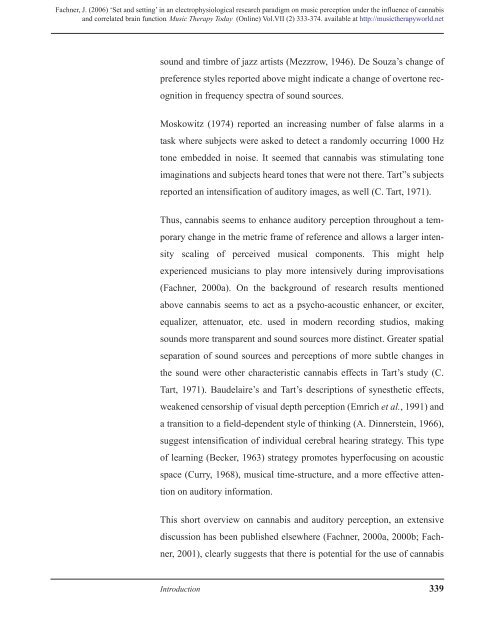Music Therapy Today - World Federation of Music Therapy
Music Therapy Today - World Federation of Music Therapy
Music Therapy Today - World Federation of Music Therapy
Create successful ePaper yourself
Turn your PDF publications into a flip-book with our unique Google optimized e-Paper software.
Fachner, J. (2006) ‘Set and setting’ in an electrophysiological research paradigm on music perception under the influence <strong>of</strong> cannabis<br />
and correlated brain function. <strong>Music</strong> <strong>Therapy</strong> <strong>Today</strong> (Online) Vol.VII (2) 333-374. available at http://musictherapyworld.net<br />
sound and timbre <strong>of</strong> jazz artists (Mezzrow, 1946). De Souza’s change <strong>of</strong><br />
preference styles reported above might indicate a change <strong>of</strong> overtone rec-<br />
ognition in frequency spectra <strong>of</strong> sound sources.<br />
Moskowitz (1974) reported an increasing number <strong>of</strong> false alarms in a<br />
task where subjects were asked to detect a randomly occurring 1000 Hz<br />
tone embedded in noise. It seemed that cannabis was stimulating tone<br />
imaginations and subjects heard tones that were not there. Tart”s subjects<br />
reported an intensification <strong>of</strong> auditory images, as well (C. Tart, 1971).<br />
Thus, cannabis seems to enhance auditory perception throughout a tem-<br />
porary change in the metric frame <strong>of</strong> reference and allows a larger inten-<br />
sity scaling <strong>of</strong> perceived musical components. This might help<br />
experienced musicians to play more intensively during improvisations<br />
(Fachner, 2000a). On the background <strong>of</strong> research results mentioned<br />
above cannabis seems to act as a psycho-acoustic enhancer, or exciter,<br />
equalizer, attenuator, etc. used in modern recording studios, making<br />
sounds more transparent and sound sources more distinct. Greater spatial<br />
separation <strong>of</strong> sound sources and perceptions <strong>of</strong> more subtle changes in<br />
the sound were other characteristic cannabis effects in Tart’s study (C.<br />
Tart, 1971). Baudelaire’s and Tart’s descriptions <strong>of</strong> synesthetic effects,<br />
weakened censorship <strong>of</strong> visual depth perception (Emrich et al., 1991) and<br />
a transition to a field-dependent style <strong>of</strong> thinking (A. Dinnerstein, 1966),<br />
suggest intensification <strong>of</strong> individual cerebral hearing strategy. This type<br />
<strong>of</strong> learning (Becker, 1963) strategy promotes hyperfocusing on acoustic<br />
space (Curry, 1968), musical time-structure, and a more effective atten-<br />
tion on auditory information.<br />
This short overview on cannabis and auditory perception, an extensive<br />
discussion has been published elsewhere (Fachner, 2000a, 2000b; Fach-<br />
ner, 2001), clearly suggests that there is potential for the use <strong>of</strong> cannabis<br />
Introduction 339

















